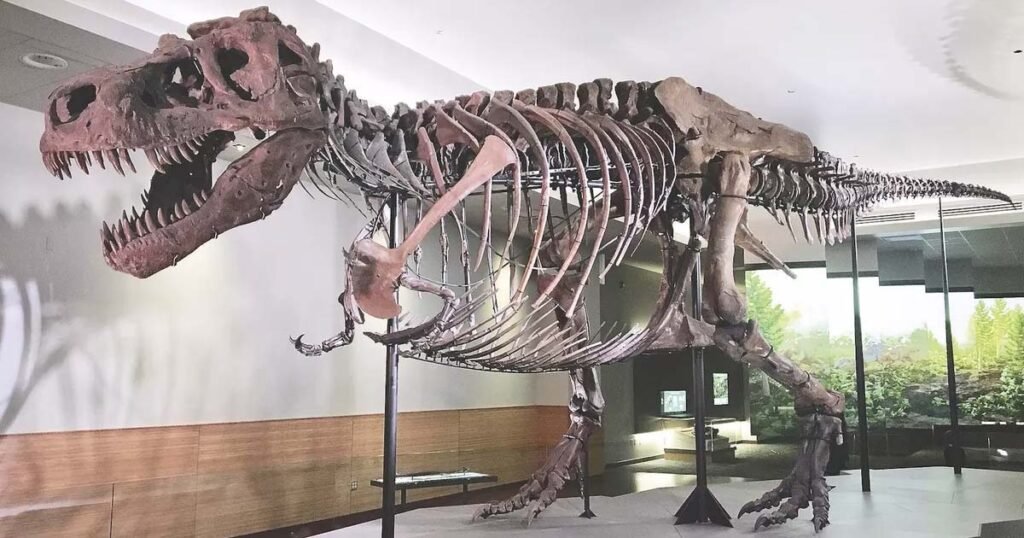Sue is the nickname for one of the best-preserved, largest, and most extensive Tyrannosaurus rex skeletons ever discovered, with over 90% of the skeleton recovered by bulk.

Sue is one of the largest T. rex skeletons ever discovered, measuring 12.8 meters (42 feet) in length. The specimen was discovered on a cattle ranch owned by Maurice Williams on the Cheyenne River Sioux reservation in South Dakota on August 12, 1990.
Susan Hendrickson, an American marine archaeologist and paleontologist for whom the specimen is named, discovered it while searching the property with American paleontologist Peter Larson.
The fossil was auctioned in October 1997 for US$8.3 million, the highest amount ever paid for a dinosaur fossil until October 7, 2020, when T. rex Stan was auctioned for US$31.8 million after ownership disputes were resolved. Sue has become a permanent exhibit at Chicago’s Field Museum of Natural History.
Discovering Sue by accident
The group had discovered Edmontosaurus bones by the end of the summer and was ready to leave. However, before the group could leave on August 12, their truck had a flat tire.
Sue decided to explore the nearby cliffs that the group had not checked out while the rest of the group went into town to repair the truck. She discovered some small pieces of bone while walking along the base of a cliff. When she looked up to see where the bones came from, she noticed larger bones protruding from the cliff’s wall.
She returned to camp with two small pieces of the bones and informed the Black Hills Institute’s president, Peter Larson, about her discovery. The bones’ distinctive contour and texture led him to believe they belonged to a T. rex. Following a closer examination of the site, many visible bones and articulated vertebrae were discovered.
The crew ordered more plaster, and despite the fact that some of the crew had to leave, Hendrickson and a few other workers began uncovering the bones. The group was ecstatic because it was clear that a large portion of the dinosaur had been preserved. T. rex skeletons previously discovered were typically missing more than half of their bones.
Sue was later found to be a record of 90% by bulk and 73% by completed counting of the elements. Around 250 T. rex bones have been recovered out of the 360 known T. rex bones.
Furthermore, the rushing water mixed the skeleton together. When the fossil was discovered, the hip bones were above the skull and the leg bones were intertwined with the ribs. The large size and excellent condition of the bones were also surprising. The skull measured 1,394 mm (54.9 in) in length, and the majority of the teeth were still present.
Sue was 28 years old at the time of death
Sue measures 12.3–12.8 meters (40–42 feet) in length, stands 4 meters (13 feet) tall at the hips, and weighs 8.4–14 metric tons (9.26–15.4 short tons) as of 2018. Other size estimates in 2011 ranged from 9.5 to 18.5 metric tons (10.5 to 20.4 short tons), though the authors noted that their upper and lower estimates were based on models with large possible errors, and that they “consider [these extremes] to be too skinny, too fat, too big, or too disproportionate.”

The skull weighs 272 kg when displayed separately from the body (600 lb). This specimen has the longest known theropod gastralium (belly rib), measuring about 90 centimeters (3.0 ft). Sue also has the longest known pubis among Cretaceous theropods, measuring approximately 136 centimeters in length (4.46 ft).
According to a close examination of the bones, it was revealed that Sue was 28 years old at the time of death. Sue suffered a broken rib, a torn tendon in her right arm, and a damaged shoulder blade as a result of an injury to her right shoulder. Sue survived the incident because the damage to her ribs healed (though one rib split into two separate pieces).
The left fibula is twice as big as the right one, which is most likely due to infection. CT scans revealed no fracture, contradicting the original reports of a broken bone. Both the left fibula and the fused c26 and c27 caudal vertebrae show signs of osteomyelitis, which is a bone infection.
Multiple holes in the front of the skull were originally thought to be bite marks from another tyrannosaur or a bacterial infection. Following further investigation, these were discovered to be areas of parasitic infection, possibly caused by an infestation of an ancestral form of Trichomonas gallinae, a protozoan parasite that infects birds and eventually causes death by starvation due to internal swelling of the neck.
Early on, damage to the back of the skull was misinterpreted as a fatal bite wound. Paleontologists from the Field Museum investigated further and discovered no bite marks. Postmortem trampling caused the distortion and breakage seen in some bones in the back of the skull. Due to injury, some tail vertebrae have fused in a pattern that is typical of arthritis. Gout is thought to have been a problem for the animal. Scholars disagree about how the animal died, and the cause of death remains unknown.
Since May 17, 2000, the fossil has been on permanent display at the Field Museum.











